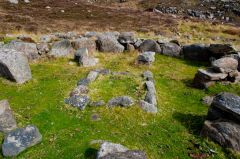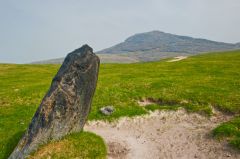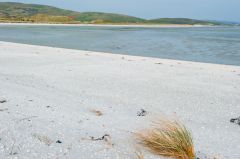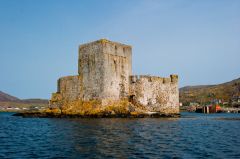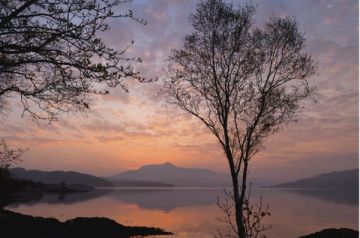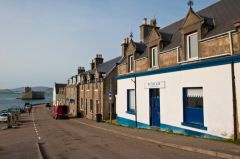
The island of Barra will forever be associated with the MacNeil clan. MacNeils have been in Barra since at least the 11th century, though it was not until 1427 that Alexander, Lord of the Isles, granted Barra to Gilleonan MacLeod.Tradition, however, claims that the family can trace its origins back to the 4th-century Irish hero Niall of the Nine Hostages, the high king of Ireland. Shortly after the MacNeils were granted Barra they built
Kisimul Castle on an island in Castlebay harbour. This wonderfully picturesque castle has now been restored and visitors can enjoy a short boat trip from the Castlebay jetty to the castle island.
The MacNeils were skilled seafarers; indeed, an old saying suggests that Noah offered the MacNeil clan chief a place on the Ark, but the MacNeil turned down the offer, saying that he had a boat of his own. And those boats the MacNeils frequently used for piracy, raiding English vessels during the reign of Queen Elizabeth I. Elizabeth's successor, James I of England and VI of Scotland, arrested the MacNeil chief, but let him go when MacNeil cleverly claimed that he targetted Elizabeth's ships because 'that woman' had killed James's mother, Mary, Queen of Scots.
The MacNeils were all-powerful within the confines of their Barra territory, but at length, that dominance came to an end. Debt forced the 21st Chief, General Roderick MacNeil, to sell Barra in 1838, to Colonel Gordon of Cluny. Colonel Gordon was one of the worst offenders during the dreadful Highland Clearances.
He forced inhabitants of South Uist, Benbecula, and Barra off their traditional crofting lands, and coerced them to emigrate to the Americas. In 1937 Robert Lister MacNeil bought back the island and took over as 45th Chief. The 46th Chief, in turn, granted almost all the land to the Scottish Executive.
Barra is forever linked to the popular novel and film, Whisky Galore, by Sir Compton Mackenzie. The events of Mackenzie's novel did not take place here; the novel describes what happened when a ship carrying whisky went aground off Eriskay. But when the film version of the novel was made, Barra was used as the setting, and many of the islanders were used as extras in the filming.
Mackenzie himself is buried at Cille Bharra, in the low-lying Eoligarry peninsula at the north end of Barra. Eoligarry is linked by a long, sandy beach known as Cockle Strand to the rest of Barra. As the name suggests, islanders come here to dig for cockles, but the beach is famous for something else entirely; it serves as the island airport.
Not surprisingly, it is the only example in Britain of an airport using beach sand for a runway. Cille Bharra is famed for more than Compton Mackenzie's grave; it is an ancient Christian site associated with St Barr, or Finbarr, and early Irish saint after whom the island of Barra is named. There are ruins of three medieval chapels at Cille Bharra, and a replica of an early Christian carved cross found on the site.
But there are many more ancient places to visit on Barra. At Borve a solitary standing stone lists at an angle above the encroaching machair, while at Cuier the ruins of an atmospheric Iron Age dun looks out over the bay. In the centre of the island lies the Neolithic chambered cairn of Dun Bharpa, while just north west of Castlebay the ruins of a medieval tower house known as MacLeod's Tower rise above a small island in Loch Tangasdale.
At the very southern end of the island, near the Vatersay causeway, is a fascinating complex of historic buildings at Allt Chrysal, where an Iron Age roundhouse stands near a traditional island blackhouse.
If you rush madly about, you can just about see all the major historic sites on Barra as part of a day trip from the Uists, but, really, the island deserves more time to explore than that. The scenery is fabulous, and the pace of life is just right.
Vatersay
Barra is joined by a fairly modern (1990) causeway to the island of Vatersay. The fact that there is a causeway at all is partly due to a tragedy involving a prize bull. Traditionally, Vatersay farmers bringing their livestock to market had to get their stock to swim across the channel to Barra and then lead them to the ferry at Castlebay.
In 1986 a highly prized bull by the name of Bernie drowned while swimming across to Barra. The publicity and resulting public pressure forced the government to put £3.8 million into building a causeway to create a permanent link between the two islands.
There is little enough to see on Vatersay, but that is part of the appeal; the island is blessedly quiet and peaceful. Vatersay is shaped like a squashed figure eight, with a large northern half joined by a narrow isthmus to a smaller southern half. The isthmus separates the two bays of Vatersay and Baigh Siar.
On the machair overlooking Baigh Siar is a memorial to those who lost their lives in one of the worst maritime disasters of history, when 348 men, women, and children drowned in the wreck of the Annie Jane in 1843.
But lest that sombre reminder put you off, close by the memorial runs the Vatersay Coastal Path, a wonderfully scenic circular trail allowing you to circumnavigate the island.
List of historic attractions on Barra and Vatersay:
- Kisimul Castle
- Cille Bharra Church
- Borve Standing Stone
- Dun Cuier Iron Age fort
- Dun Bharpa chambered cairn
- MacLeod's Tower
- Allt Chrysal ancient settlement
Related:
Benbecula
Berneray
Eriskay
Lewis and Harris
North Uist
South Uist
